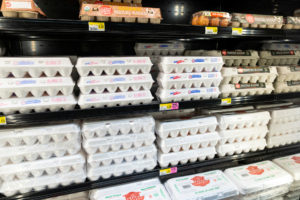- South Texas Students Meet Accordion Music Icons Los Tigres Del Norte In Edinburg Thanks To Khs America/Hohner Alianza Académica Initiative
- Fragile Planet Offers a Nighttime Wildlife Experience
- Falcons Soccer Off & Running
- Cameron County Receives Funds to Improve Two Parks
- Falcons Complete First Half of 32-6A
- School District to Help out Victims of California Wildfires
- Sand Castle Days Continued Despite Unexpected Weather
- Ready for District
- Discussion of Garbage Dumpster Rates, Agreements Between State & City on Highway Regulations, and More
- 31st Annual Shrimp Cook-Off is Right Around the Corner
Egg Prices Are High, Could Go Higher
- Updated: February 9, 2023
Written by Adam Russell
Egg prices continue to set all-time per-dozen price records, and a Texas A&M AgriLife Extension Service expert does not expect that trend to reverse in the near future.
David Anderson, Ph.D., AgriLife Extension economist, Bryan-College Station, said inflationary pressure and the worst avian flu outbreak in U.S. history have combined to send egg prices upward over much of the last year.
For a year-to-year comparison, prices reached $4.25 per dozen on average in December 2022 across the nation, according to a U.S. Department of Agriculture retail egg report. A dozen eggs was $1.79 at the same time last year.
The previous peak price occurred in September 2015 – $2.97 per dozen – and was also attributable to an avian influenza outbreak.
Anderson said he has been inundated with media requests on the subject as the topic of egg prices has become a major talking point among the consuming public.
“One reporter in Houston interviewed a backyard producer who told them this is the first time ever that it’s been cheaper to produce eggs than buy them at the store,” he said. “The situation with egg prices is something people are following now, but I think it is also something that happened over the course of time with several factors aligning.”
Avian flu driving egg prices upward
Higher production and logistical costs like feed and fuel have contributed, but the top factor driving egg prices to record highs is an ongoing outbreak of avian influenza, Anderson said. The highly pathogenic viral disease hit the U.S. poultry industry in early 2022 and cases continue to pop up at poultry farms nationwide.
The USDA-Animal and Plant Health Inspection Service, USDA-APHIS, reported almost 58 million commercial poultry birds, including broiler and egg-laying chickens, turkeys and various fowl have been lost to the virus, now reported in 46 states.
The USDA estimated around 43 million egg-laying hens were cut from the U.S. flock through December. The disease hits egg-laying chicken flocks harder because birds are in production much longer than broiler chickens, which increases their risk of exposure to the pathogen.
The losses resulted in U.S. egg inventories that were 29% lower than January 2022, according to the report.
Anderson said the avian flu struck at a time when egg layer numbers had already been reduced.
There were 340 million table egg layer hens in the U.S. flock in December 2019. By December 2020, table layer numbers had been reduced by 13 million hens, to 327 million, as egg production responded to the COVID-19 pandemic and higher feed costs. The number of table layers remained static through December 2021, and then the avian influenza outbreak dropped the number of hens below 300 million by June.
Profit incentive has pushed poultry producers to restore flock numbers amid the outbreak, but egg-producing operations continue to be hit by the disease. USDA-APHIS disease control and containment protocol calls for euthanization and disposal of all birds in a house exposed to the disease.
“We’ve seen producers respond by building back the flock numbers, but farms are still getting wiped out,” he said. “They were up to 308 million by December 2022, but it’s two steps forward, one step back.”
Egg demand peaks around Easter
Wholesale prices continue to rise, which indicates retail egg prices have not peaked, he said. The teetering flock numbers couldn’t come at a worse time for consumers.
The January USDA egg report showed prices were steady to slightly lower than December, but yearly prices for eggs often peaks each spring due to Easter holiday egg hunts and baking, he said.
“We have a built-in holiday-driven demand for table eggs,” he said. “That demand bump is on the horizon, but the higher prices are also a signal to consumers to use less, so it will be interesting to see if there will be a demand adjustment this Easter.”




